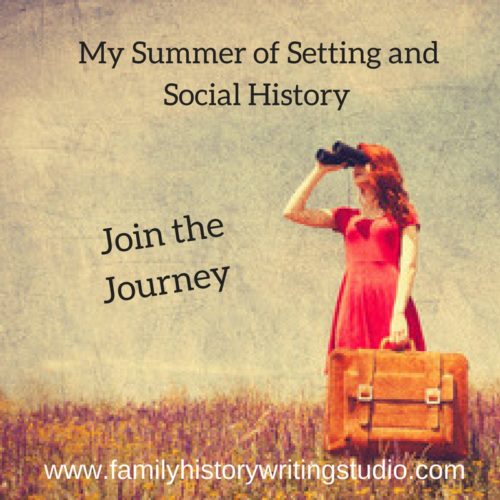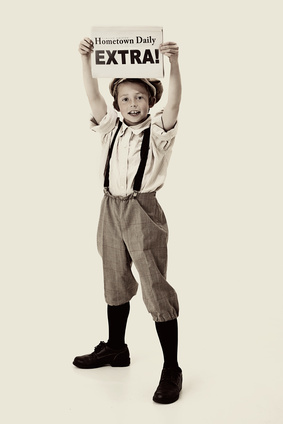Watch today’s Storylines to learn how to tap into social history and historical context to fill in the gaps in your knowledge about your ancestor. Discover how to bring a deeper, more meaningful and whole story to your readers.
How to Use Social History to Tell a Whole Story
2 thought on “How to Use Social History to Tell a Whole Story”
Comments are closed.
Related Post

World BuildingWorld Building
I’ve been thinking a lot about my ancestor’s world as of late as I prepare to write the story of my 4th great grandfather. John Phelan immigrated from Kilkenny, Ireland to Stratford, Ontario in 1833. I’m not going to give away the plot, but I will tell you that it takes place in Stratford, Ontario in 1847. It revolves around 2-3 days and involves many of the local townspeople. Before I sit down to write I need to have a clear picture of what Stratford looked like in 1847, I want to understand the personality of this community and its people. I want my readers to experience Stratford in 1847, I want it to be as authentic as possible. So, in a few weeks time, I’m heading to Stratford for a little local and social history research. I’ll keep you posted. But let’s take a look at some of setting elements I’m going investigate while in Stratford to help build my ancestor’s world.
If you’re writing your family history stories, then you’re probably aware of the importance setting plays in writing stories. By giving great detail and description to the setting we bring that world to life for the reader, drawing them deeper into a different place and time and making the ancestor’s life and the event we are recreating on the page come to life for the reader.
Too often we rely on the old standbys to create story setting, reliables like landscape, architecture, rooms, furniture, and the climate is predictable in a story setting.
Unfortunately, too many writers stop there when there is likely a lot more detail and description that we might be able to include to paint a clearer more realistic and accurate picture of our ancestor’s life.
Let’s push beyond the obvious and consider some other aspects of our ancestor’s world that could help bring the setting to the page for the reader.
8 of My Favourite World Building Details
- Food – I love to use food where possible because it can be a great sensory experience, allowing us to use a good majority of our senses when we describe it, hear, feel, see, smell and touch. Look for the types of food you’re your ancestor would have cooked, the everyday dishes, special occasion food, what was the local agriculture to the area and how did they prepare and cook their meals.
- Government and Politics – We often underestimate how much the world and local politics affected our ancestors. Who rules? Kings? Queens? Presidents? Dictators? How did government affect our ancestor’s lives? Consider taxes, for instance, local taxes could put a strain on a family and that could easily be reflected in their surroundings, what they could afford and their opinions and dialogue. Sometimes it even caused them to pick up and move.
- Health – Our ancestor got sick, even died. How does healthcare work into the time of your ancestor? How did society treat sick people? How did they perceive medicine? Doctors? What were the practices of the time? What medications were available, doctors visits, general health practices?
- Communication – How did your ancestor communicate with others in the town, with their neighbours or families far away. Even in one town, there could be a variety cultures and therefore languages, there also might be a variety of dialects, slang words and accents.
- Currency – What was the currency of the day? Did your ancestor use paper money or coins? Did the local shopkeeper manage accounts for the townspeople or was bartering a common occurrence.
- Religion – You don’t have to be religious to understand that religion had a great influence on how our ancestors behaved. It influenced their movements, thoughts and behaviours. It is impossible not to have religion in your ancestor’s town. Religion is a foundational element to all cultures. They affect the way people eat, sleep and relate to others. There may be multiple religions in your ancestor’s village. Learn about the local religions, their moral codes, beliefs and history so you can better understand the make-up of your ancestor’s village.
- Races – Did your ancestor live in a multi-cultural community? How did this affect their behaviour, their exposure to different foods, clothing and beliefs? How did they view others races? Did racism exist in their community? Did your ancestor live in a liberal community that embraced diversity?
- Recreation – What did your ancestor do for fun? Did they play sports or other activities that were part of their daily life? Did they read? Play board games? Tell stories? How they spent their free time reflects their cultures and enriches your world building.
Where to Find World Building Details
A little research into the local and social history of your ancestor’s part of the world can help to reveal how some of these elements were a part of their world. Now by now means is this a complete list. You can find a much more extensive list in Authentic Ancestors. But it is a great representation that can help us push beyond the standard description of their surroundings, dig a little deeper to truly understand the world they were living in and build that world with confidence for your reader. Look at your library, online libraries, historical societies, genealogical centres, newspapers, letter and diaries and city directories to help you flesh out the setting and social history details.
Recently I spent some time on Amazon looking for local and social history books for my upcoming writing project. I found some great resources, but they shouldn’t take the place of visiting the archives and museums of the local areas that your ancestor lived. Don’t just use one resource but a variety to build your ancestor’s world.
Here are some of my recent discoveries on Amazon.
These first two are going to help me out a great deal with my upcoming project.
The Backwoods of Canada, (download to Kindle for .99)
I also stumbled upon this a series of books called A Writer’s Guide to Everyday Life, each book addresses a different time period. I thought they might come in handy for some of you.
Everyday Life in Colonial America
Everyday Life in the Middle Ages
Everyday Life in the Wild West
Everyday Life During the Civil War
Everyday Life from Prohibition through to World War II
Everyday Life in Renaissance England
( I do receive a small compensation from Amazon if you purchase through one of these links.)
Now, we’ve offered up lots of ideas. Of course, we don’t want to overdo it. We might have to pick and choose which details and descriptions best suit our story. It’s up to you to decide what will ultimately serve your story and reader. We can’t include it all, but it’s nice to know we have options. Take some time before you write to research and learn what setting options are available to you so that you can build your ancestor’s world with authenticity.
Watch for future instalments of My Summer of Setting and Social History. Come along with me on my travel and writing journey. Next: Creating a Setting and Social History Research List.

Enriching Your Story with HistoryEnriching Your Story with History
In the Getting Ready to Write and Authentic Ancestors workbooks, I mentioned historical timelines and their importance in organizing your research and writing your ancestor’s stories. Not only is it important to map your ancestor’s life on a timeline, but also to map world, regional and local history. It’s necessary to consider what was happening in the world around your ancestors and it’s relationship to their life.
I want to spend a few minutes today discussing how we can use historical events to enrich your stories.
Historical events can provide both a background and a setting for your story. However, while these events can add a lot of colour and depth to your story, it’s important to not just insert a historical event in your ancestor’s narrative only because it happened during their life. It’s important to look at how those events may have impacted your ancestor’s life, actions, and reactions. While some events will be easy to include due to your ancestor’s direct relationship to an event, do not discount an event because it did not happen directly to them. It may be happening in the background and influencing their life.
These historical events can happen before, after or during the story. It may be something from the past that sets in motion a current event in your story. Historical events can add richness to your story and can place your ancestor’s life and story within the context of the world. It can also help to establish the tone of your story for your reader. By linking your ancestor’s story to something happening or that has happened, this event may impact them or people around them. It’s important to consider how the event may change their feelings, attitudes, culture, or society.
These historical events may strengthen your story ideas and feed your ancestor’s stories. Perhaps your ancestor’s story will be a political or social statement about abortion, adoption, slavery, corruption in politics or the environment to name but a few. You can look to historical events to help you build your story ideas and theme.
An excellent resource for looking at events in a variety of categories is The Timetables of History by Bernard Grun. This book is organized into seven categories, history and politics, literature and theatre, religion, philosophy and learning, visual arts, music, science, technology and growth, and daily life. It spans from 5000BC up to 1991 and is organized on a year by year basis.
I’ve also provided you with a small chart below for you to download and use if looking at the historical events of your ancestor’s life and analyzing them for the impact on their lives. Completing this chart might help you to shape your story with regards to plot, theme, and your story question.
Don’t limit yourself to just the large world events. Regional and local historical events must also be considered. We often think wars and national tragedies when discussing historical events. However, a local storm that causes devastation to area crops or local politics may play a significant role in your ancestor’s life and decisions.
Historical events provide context and richness to your story, and it places our ancestor in the world making them more real and believable to your reader.
Here’s the timeline with a couple of examples filled in.
Thank you, that is just what I needed at this moment!
Thank you Lynn. This helps me add another layer to my story … after I’ve done the research, of course!